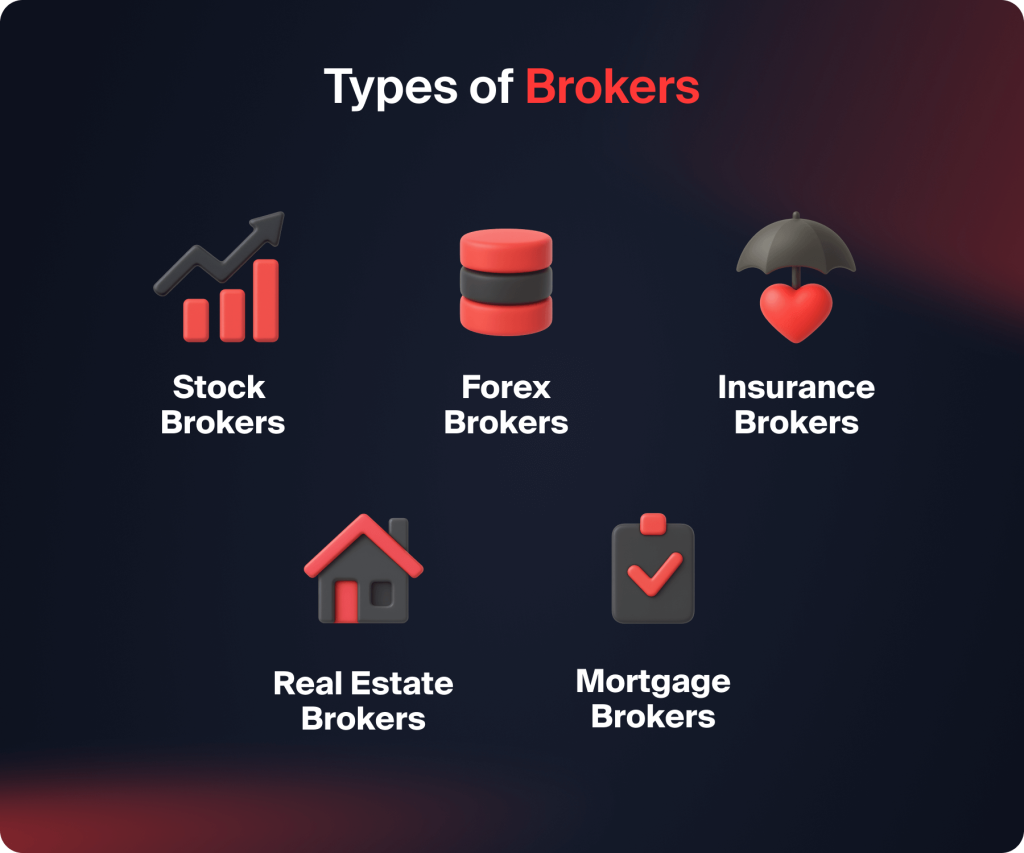
브로커란 무엇인가? (실제로 작동하는 것처럼 간단하게 설명)
목차
브로커는 기본적으로 당신이 혼자서는 접근할 수 없는 것에 대한 접근을 제공하는 사람입니다 – 금융 시장, 주택 담보 대출 거래, 보험, 또는 심지어 부동산 구매입니다. 그들은 당신이 구매하는 것을 항상 소유하고 있는 것은 아닙니다. 그들은 거래가 이루어지는 장소에 당신을 직접 연결해주는 사람들입니다. 그리고 그것을 가능하게 하기 위해, 그들은 수수료를 받습니다.
이렇게 생각해 보세요 – EUR/USD와 같은 통화를 거래하거나 애플 주식을 구매하려면, 단순히 노트북을 열고 월스트리트에서 직접 거래를 할 수는 없습니다. 규제된 플랫폼, 거래 시스템, 유동성 제공업체, 라이센스 및 은행과의 연결이 필요합니다. 중개인은 이미 모든 것을 구성해 두었으므로, 계정을 열고, 돈을 입금한 후, 구매 또는 판매를 클릭하면 나머지는 백그라운드에서 자동으로 작동합니다.
브로커의 역할은 고객과 시장 간의 접근, 속도 및 원활한 경로를 제공하는 것입니다.

그래서 브로커는 실제로 어떻게 작동하나요?
간단히 말하면, 중개인의 시스템은 고객이 주문을 하고 그 주문이 시장에서 실행될 수 있게 합니다. 외부에서는 이 과정이 매우 간단해 보입니다 - 플랫폼에서 버튼을 누르면 거래가 포트폴리오에 나타납니다. 그러나 화면의 반대편에서는 여러 가지 일이 즉시 발생합니다:
- 중개인의 플랫폼이 당신의 잔액이 충분한지 확인합니다
- 주문을 유동성 공급자 또는 내부 시스템에 전송합니다
- 가격이 확인되었습니다
- 위치가 밀리초 이내에 열립니다
그들은 또한 모든 것이 합법적이라는 것을 확인합니다 – 신원 확인, 자금 세탁 방지 검사, 거래 내역 저장.
물론 그들은 돈을 법니다. 중개인은 스프레드(매수 가격과 매도 가격 사이의 작은 차이), 거래당 수수료, 야간 스왑 수수료 또는 고정 서비스 수수료에서 수익을 얻습니다. 부동산 중개인은 부동산 판매에서 수수료를 받고, 보험 중개인은 보험 제공자로부터 일정 비율을 받습니다.
다양한 유형의 브로커 (금융뿐만 아니라)
“브로커”라는 단어를 들으면 우리는 보통 거래를 생각하지만, 브로커는 금융 외에도 훨씬 더 많은 분야에 존재합니다.

- 외환 및 CFD 브로커는 여러분이 통화 거래, 금, 석유, 암호화폐 및 기타 시장에 접근할 수 있도록 해주는 브로커입니다. 그들은 거래 플랫폼, 차트, 가격 및 사람들이 거래를 하기 위해 사용하는 모든 도구를 제공합니다. 그들은 주로 스프레드 또는 수수료로 돈을 벌고 있습니다.
- 주식 중개인은 기업의 주식을 구매할 수 있게 해줍니다. 이들 중 일부는 전통적인 회사이고, 다른 일부는 전체 주식 대신 작은 주식을 구매할 수 있는 간단한 모바일 앱입니다.
- 암호화폐 중개인은 비트코인이나 이더리움과 같은 디지털 자산을 가지고 거의 같은 일을 합니다. 어떤 중개인은 거래소처럼 작동하고, 어떤 중개인은 거래 플랫폼처럼 더 많이 작동합니다.
- 바이너리 옵션 브로커는 실제로 자산을 구매하지 않는 곳입니다. 특정 시간 내에 가격이 상승할지 하락할지를 예측하는 것뿐입니다. 맞추면 고정된 수익을 얻고, 틀리면 투자한 금액을 잃게 됩니다.
- 부동산 중개인은 사람들이 재산을 사고 파는 데 도움을 줍니다. 그들은 매물 목록을 찾고, 시청을 조직하며, 협상을 처리하고, 서류 작업을 처리합니다.
- 모기지 브로커는 직접 대출을 제공하지 않습니다. 그들은 다양한 은행을 비교하고, 최상의 금리를 찾아주며, 승인받는 데 도움을 줍니다.
- 보험 중개인은 보험 회사와 같은 방식으로 일합니다. 그들은 하나의 제공자를 밀어붙이지 않고, 대신 여러 옵션을 살펴보고 실제로 적합한 것을 선택하는 데 도움을 줍니다.
따라서 개념은 항상 동일합니다 - 중개인은 사람들이 직접 협상할 수 없는 거래를 성사시킬 수 있도록 돕습니다.
브로커 vs 딜러 – 왜 중요한가
사람들은 종종 이 둘을 혼동합니다. 중개인은 두 쪽을 연결하고 그들을 도와주는 대가로 수수료를 받습니다. 그들은 금융 위험을 감수하지 않습니다. 반면, 딜러는 자산을 직접 사고 팔고 가격 차이로부터 이익을 얻습니다.
예를 들어, 외환 브로커는 시장에 대한 접근을 제공하고 소액의 스프레드를 부과합니다. 자동차 딜러는 먼저 자동차를 구매한 다음 더 높은 가격에 여러분에게 판매합니다. 하나는 연결하고, 다른 하나는 소유합니다.
브로커는 어떻게 돈을 벌까? (현실적으로, 교과서 스타일이 아닌)
대부분의 사람들은 중개인이 수수료로만 돈을 번다고 생각하지만, 그건 이야기의 일부에 불과합니다. 사실, 중개인은 여러 가지 수입원을 가지고 있으며, 그 중 대부분은 사용자가 거의 인식하지 못하는 방식으로 거래 과정에 내장되어 있습니다.
가장 일반적인 것은 스프레드입니다 – 매수 가격과 매도 가격의 차이입니다. 예를 들어, EUR/USD를 1.1000에 구매하고 1.0998에 판매할 수 있다면, 그 0.0002의 차이가 브로커가 이익을 얻는 부분입니다. 별도의 수수료로 지불하지는 않으며 – 이미 화면에서 보는 가격에 포함되어 있습니다.
그 다음에는 거래당 수수료가 있습니다. 특히 주식 및 ECN 외환 브로커에서 그렇습니다. 때때로 거래당 또는 로트당 고정 수수료가 있습니다.
클라이언트가 거래를 하루 밤 동안 열어두면, 스왑 또는 롤오버 수수료가 적용됩니다 - 이는 관련된 통화에 따라 조정되는 이자입니다. 일부 브로커는 거기에도 약간의 마크업을 추가합니다.
부동산이나 보험과 같은 산업에서는 더 간단합니다 - 중개인은 거래가 성사되면 판매자나 보험 제공자로부터 수수료를 받습니다. 모기지 중개인은 계약에 따라 은행이나 고객으로부터 수익을 얻을 수 있습니다.
그래서 브로커들이 이것을 친절에서 하는 것은 아닙니다 - 비즈니스 모델은 확고하고 확장 가능하며, 제대로 실행된다면 매우 수익성이 높습니다.
브로커리지를 실제로 시작하는 방법 (설탕을 입힌 버전이 아님)
솔직히 말하자면 – 브로커리지 시작하기는 웹사이트를 설정하고, 로고를 선택하고, “우리와 거래하세요”라는 광고를 게시하는 것을 의미하지 않습니다. 여러분이 보는 모든 거래 플랫폼 뒤에는 인프라, 법적 작업, 유동성 연결, 위험 관리 및 많은 규정 준수가 있습니다. 하지만 그것이 불가능하다는 의미는 아닙니다. 그것이 정말로 의미하는 것은 – 여러분이 트레이더나 개발자가 될 필요는 없다는 것입니다. 여러분은 사업주처럼 생각해야 합니다.
전통적으로 시작하는 방법은 두 가지가 있었습니다:
- 모든 것을 처음부터 구축하기 – 나만의 플랫폼을 만들고, 개발자를 고용하고, 유동성을 연결하고, 라이센스를 받고, CRM, 결제 시스템 및 거래 서버를 구축하세요. 이 과정은 1년 이상 걸릴 수 있으며, 쉽게 $300,000 이상의 비용이 들 수 있습니다.
- 화이트 라벨 솔루션 선택하기 – 이미 모든 것을 구축한 회사가 귀하의 브랜드로 그들의 시스템을 사용할 수 있게 해줍니다.
화이트 라벨로 중개업체 시작하기 (실제로 어떻게 작동하는가)
플랫폼을 코딩하거나 은행 또는 데이터 제공자와 개별 계약을 체결할 필요가 없습니다. 화이트 라벨 솔루션을 사용하면 프로세스는 다음과 같습니다:
- 신청하고, 데모를 받고, 트레이더룸과 백 오피스가 어떻게 작동하는지 확인하세요
- 브랜딩을 선택하세요 – 로고, 도메인, 색상 팔레트
- 그들은 유동성, 거래 도구, CRM, 결제 및 KYC 시스템을 연결합니다.
- 당신은 계약서에 서명합니다
- 약 14일 후에, 귀하의 중개업체가 고객을 온보드할 준비가 됩니다
그리고 예 – 자신의 비즈니스 모델(A-book, B-book 또는 하이브리드)을 선택하고, 자신의 스프레드와 수수료를 설정하며, 원한다면 자신의 결제 시스템이나 유동성 공급자와 연결할 수 있습니다.
이 접근 방식이 작동하는 이유는 당신이 진정으로 당신이 필요한 부분, 즉 고객 유치, 지원 처리 및 전략적 결정에만 집중하고 있기 때문입니다. 모든 기술적, 법적 통합 관련 및 인프라 중심의 작업은 당신을 위해 처리됩니다.
중개업을 열려면 얼마나 드나요?
이것은 사람들이 가장 먼저 묻는 질문 중 하나이며, 또한 대부분의 회사가 명확하게 대답하는 것을 피하는 질문 중 하나입니다. 그러니 직접적으로 말씀드리겠습니다.
화이트 라벨을 선택하고 제로에서 자신의 플랫폼을 구축하지 않기로 결정하면 초기 투자 비용은 $25,000와 $50,000 사이가 될 것입니다. 예를 들어 Quadcode와 함께:
- $25,000 – 기본 패키지 (거래 플랫폼 + 유동성 + CRM + 백 오피스)
- $37,000 – 고급 (위와 동일 + KYC 시스템 + 안티사기 + 더 많은 통합)
- $50,000 – 전체 (모바일 앱, 제휴 추적, 결제 시스템, 판매 도구 추가)
그러면 지속적인 비용이 발생합니다: 플랫폼 호스팅, 유동성 수수료, 아마도 지원 관리자나 마케팅 전문가. 하지만 기억하세요 – 당신은 서버를 구축하지 않고, 5명의 개발자를 고용하지 않으며, 자신의 거래 소프트웨어에 20만 달러를 지불하지 않습니다.
이 모든 것을 스스로 구축하려고 했다면, 플랫폼만으로도 150,000달러에서 300,000달러가 들고 개발에 8-12개월이 걸릴 수 있습니다. 라이센스를 신청하거나 단일 결제 시스템을 연결하기 전에 이야기입니다.
라이센스가 필요하신가요?
당신이 운영하는 위치와 고객의 위치에 따라 다릅니다. 일부 국가는 운영하기 전에 중개인 라이센스를 요구합니다. 다른 국가에서는 소규모 중개인이 라이센스 없이 시작할 수 있는 해외 구조를 허용하고 나중에 규제된 관할권으로 이동할 수 있습니다.
예를 들어:
- EU 또는 UK에서는 라이센스가 필요합니다 (영국의 FCA, 키프로스의 CySEC)
- 호주에서 – ASIC 라이선스
- 미국에서는 매우 엄격하며, 여러 번의 등록이 필요합니다 (SEC, CFTC, FINRA)
- 세이셸이나 세인트빈센트와 같은 해외 관할권에서는 일부가 시작할 때 전혀 라이선스를 요구하지 않습니다.
그러므로, 만약 어떤 나라가 중개 라이센스를 법적으로 요구하고 당신이 그 특정 시장을 목표로 하고 싶다면 - 그렇다면 당신은 그것을 가져야 합니다. 그렇지 않다면, 그것 없이 시작할 수 있지만 여전히 KYC/AML 규칙을 따라야 합니다.
우리 기사를 확인하세요: 브로커리지 라이센스를 얻는 방법 및 신청할 곳은?
브로커리지 소유자로서 실제로 당신이 책임져야 하는 것은 무엇인가요
많은 사람들이 중개업체를 열려면 개발자를 고용하고, 서버를 다루고, 유동성 제공자와 논쟁하고, 새벽 3시에 플랫폼 오류를 수정해야 한다고 생각합니다. 이는 전체를 처음부터 구축하려고 할 때만 발생합니다. 적절한 화이트 라벨 설정을 사용할 때, 당신의 역할은 기술적이기보다는 훨씬 더 비즈니스 중심이 됩니다.

당신의 일은 실제로 대부분 사람들이 생각하는 것보다 훨씬 간단합니다. 당신은 고객을 유치하고, 그들이 필요할 때 지원을 받을 수 있도록 보장하며, 비즈니스가 돈을 버는 방식을 관리합니다. 그게 거의 핵심입니다.
거래 플랫폼, 시장 데이터, 유동성 연결, 모바일 앱, 결제 통합, KYC 흐름, 업데이트, 일일 시스템 모니터링 등 나머지 모든 것은 제공자가 처리할 수 있습니다. IT 엔지니어 팀이나 서버룸이 필요하지 않습니다. 소규모로 시작하고, 시장을 테스트하며, 의미가 있을 때만 확장할 수 있습니다.
플랫폼 (트레이더들이 가장 먼저 보고 당신을 판단하는 것)
당신은 최고의 가격, 신뢰할 수 있는 유동성, 심지어 라이센스를 가지고 있을 수 있지만, 만약 당신의 거래 플랫폼이 구식으로 보이거나 느리게 느껴진다면 사람들은 떠날 것입니다. 플랫폼은 트레이더들이 당신을 신뢰할지 말지를 결정하는 첫 번째 장소입니다.
현대의 브로커들은 MT4나 MT5와 같은 대용량 다운로드를 피하고 데스크탑과 모바일에서 즉시 작동하는 웹 기반 플랫폼을 선호합니다. Quadcode가 사용하는 접근 방식입니다. 브라우저에서 로그인하면 되고, 전체 설정을 선택하면 자신만의 브랜드 iOS 및 Android 앱도 갖게 됩니다.
이 플랫폼은 빠른 거래 실행, 원클릭 거래, 100개 이상의 지표, 다양한 차트 레이아웃 및 간단한 탐색 기능을 갖추고 있습니다. 플러그인 없이, 수동 설치 없이, 복잡한 설정 없이. 귀하의 브랜드, 색상 및 로고를 적용하면 이미 귀하의 제품처럼 느껴집니다.
마지막 생각
중개인은 사람들이 혼자서는 들어갈 수 없는 시장에 접근할 수 있도록 도와줍니다. 오늘날의 차이점은 이를 가능하게 하기 위해 기술을 직접 구축할 필요가 없다는 것입니다. 더 빠르게 시작하고, 아이디어를 테스트하며, 인프라 대신 성장에 집중할 수 있습니다.
코딩이나 전문적으로 거래할 필요는 없습니다. 명확한 계획, 목표 고객, 그리고 비즈니스를 더 어렵게 만들지 않는 플랫폼이 필요합니다. 이러한 요소들이 갖추어지면 나머지는 확장하는 문제로 바뀝니다.
FAQ
아니요. 당신은 비즈니스 사람이 되어야 합니다. 기술, 유동성 및 리스크 시스템은 아웃소싱할 수 있습니다. 아웃소싱할 수 없는 것은 당신의 비전과 사람들을 끌어들이는 능력입니다.
If the country you operate in legally requires it, then yes. If not, you can start without one but still follow KYC and AML rules.
$17,000에서 시작하여 포함하는 내용에 따라 플랫폼, CRM, 유동성, 앱 등으로 $50,000까지 올라갑니다.
약 두 주 후 모든 것이 승인됩니다.
기술을 위한 것이 아닙니다. 모든 것을 스스로 처리하고 싶지 않다면, 지원을 위한 누군가와 마케팅을 위한 누군가만 필요합니다.
업데이트:
2025년 11월 26일



